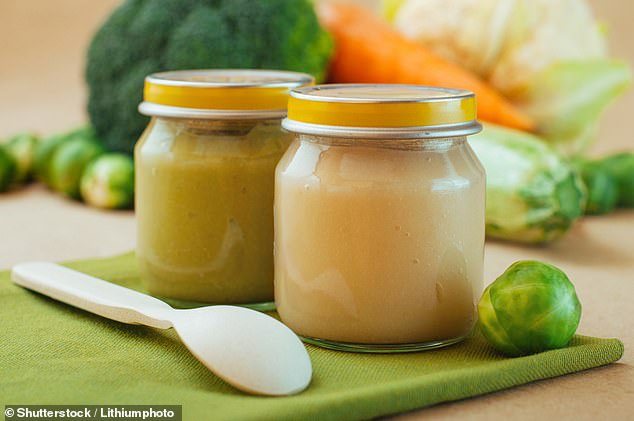Most parents will remember the hours they spent spooning pureed food into their children’s mouths.
But allowing babies to feed themselves with their hands may be better for their growth, according to a study.
New findings suggest that baby-led weaning, a popular way to introduce solid foods to infants, provides enough calories for growth and development.
The method emphasizes allowing babies to hand-feed whole, non-puréed foods when introducing solids, as opposed to the more traditional approach of spoon-feeding babies pureed solids.
Proponents say it encourages healthy eating habits because babies feed themselves and can explore a variety of foods from family meals.
Instead of spoon-feeding, a new study has found that allowing babies to feed themselves with their hands may be better for their growth (File image)
Researchers at the University of Colorado studied baby-led weaning in 70 healthy five-month-old babies.
During the study, caregivers recorded three days of all food intake by the infant.
The team classified a child as following the baby-led weaning method if less than 10 percent of his or her calories came from pureed infant foods.
The analysis revealed that there were no significant differences in energy intake between the two weaning groups.
Baby-led weaning was also associated with a greater increase in weight-for-age and weight-for-length scores than conventionally weaned babies, meaning they had higher growth trajectories.
The team said soft fruits, steamed vegetables, cheese and small pieces of meat are good foods to try in baby-led weaning because they are easy to grasp and chew.
Foods should be offered in the form of fist-sized sticks to prevent choking, they said, adding that it is important to provide a varied and diverse diet when introducing solid foods to babies.
Study author Kinzie Matzeller, a registered dietitian, said: ‘One of the main concerns with baby-led weaning was that it was not known whether it provided enough nutrients to support infant growth.

Instead of pureed foods, soft fruits, steamed vegetables, cheese and small pieces of meat are good foods to try during baby-led weaning (stock image)
‘It is reassuring to know that baby-led weaning provides adequate calories for growth.
‘Baby-led weaning can be a great way to incorporate more choices and different types of foods that your little one might not otherwise get.
“It often takes up to 15 exposures to a food before a baby accepts it, so perseverance is key.” They also found that mothers with more education and higher incomes were more likely to use baby-led weaning.
This could be because wealthier families may find it easier to afford the time and resources needed to prepare foods needed for baby-led weaning, the researchers said.
Her future research will examine potential nutritional differences between weaning methods.
The findings were presented at the American Society for Nutrition conference in Chicago.


